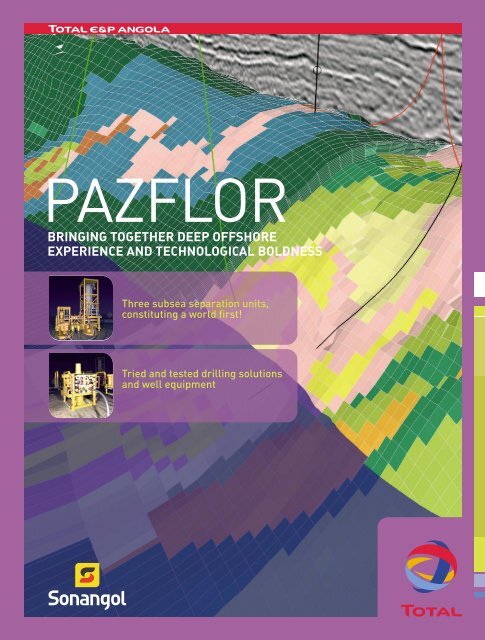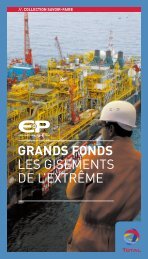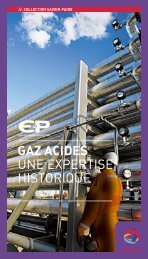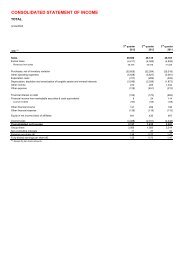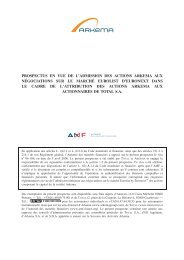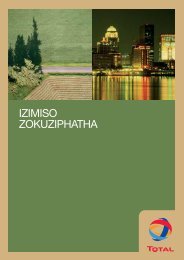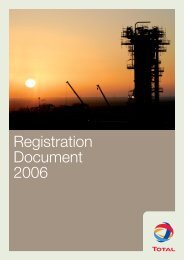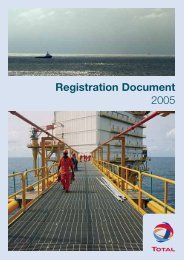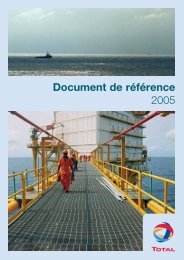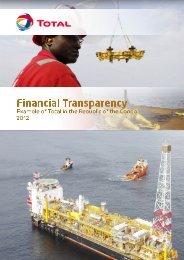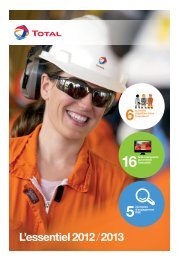Pazflor, deep offshore experience and technological ... - Total.com
Pazflor, deep offshore experience and technological ... - Total.com
Pazflor, deep offshore experience and technological ... - Total.com
You also want an ePaper? Increase the reach of your titles
YUMPU automatically turns print PDFs into web optimized ePapers that Google loves.
PAzFlOr<br />
bringing together <strong>deep</strong> <strong>offshore</strong><br />
eXperienCe <strong>and</strong> teChnologiCal boldness<br />
three subsea separation units,<br />
constituting a world first!<br />
tried <strong>and</strong> tested drilling solutions<br />
<strong>and</strong> well equipment
PAzFlOr<br />
bringing together <strong>deep</strong> <strong>offshore</strong><br />
eXperienCe <strong>and</strong> teChnologiCal boldness<br />
the first world develoPment to install entire seabed artificial lifting<br />
Production systems associating gas/liquid seParation <strong>and</strong> PumPing<br />
<br />
<br />
modules on several fields, <strong>Pazflor</strong> marks a new steP forward<br />
<br />
in the conquest of the deeP <strong>offshore</strong> <strong>and</strong> confirms the grouP’s<br />
<br />
influential contribution to sustainable energy growth in angola.<br />
<br />
<br />
<br />
<br />
<br />
<br />
<br />
<br />
<br />
<br />
ConCessionaire<br />
of bloCk 17 SOnAnGOl<br />
– 2 000 m<br />
250 km<br />
<br />
<br />
<br />
– 1 500 m<br />
<br />
<br />
<br />
<br />
<br />
<br />
<br />
<br />
<br />
<br />
<br />
– 1,000 m<br />
– 200 m<br />
<br />
<br />
– 100 m<br />
<br />
<br />
<br />
<br />
<br />
<br />
<br />
<br />
<br />
<br />
<br />
<br />
<br />
<br />
<br />
<br />
<br />
– 2,000 m<br />
<br />
<br />
<br />
<br />
<br />
<br />
<br />
– 1,500 m<br />
<br />
<br />
<br />
<br />
<br />
partners<br />
TOTAl (OPERATOR) STATOilHyDrO ESSO BP<br />
40% 23.33% 20% 16.67%<br />
–1,000 m<br />
–200m<br />
–100 m
Combining<br />
innovation <strong>and</strong><br />
teChnologiCal<br />
robustness<br />
<strong>Pazflor</strong>, the third production hub on Block 17, due to start<br />
production in 2011, reiterates <strong>Total</strong>’s <strong>com</strong>mitment to pushing<br />
the frontiers of the <strong>deep</strong> <strong>offshore</strong> ever further. Capitalising<br />
on the <strong>experience</strong> acquired on Girassol/Jasmim/Rosa <strong>and</strong><br />
Dalia, the Group <strong>com</strong>bines on <strong>Pazflor</strong>, tried <strong>and</strong> tested<br />
<strong>technological</strong> solutions <strong>and</strong> innovation, optimising the<br />
management of the risks inherent to the challenges raised<br />
by this major development for the Group <strong>and</strong> for Angola.<br />
Stretching out over almost 600 km 2 , at water depths of<br />
between 600 to 1,200 metres, <strong>Pazflor</strong> <strong>com</strong>bines two<br />
developments in one: two subsea production systems<br />
dedicated to two different oils (Miocene <strong>and</strong> Oligocene)<br />
linked to 49 production <strong>and</strong> injection wells <strong>and</strong> supplying<br />
a single FPSO (Floating Production, Storage <strong>and</strong> Offloading),<br />
a 114,000 tonne colossus of steel <strong>and</strong> installations designed<br />
to process the mixing of these two oils.<br />
The main challenge concerning the Miocene reservoirs<br />
is the extraction of a heavy (17 to 22°API) <strong>and</strong> highly viscous<br />
oil, through 35 wells (18 producers <strong>and</strong> 17 water injectors).<br />
To meet this challenge, <strong>Total</strong> based its development scheme<br />
on the concept of seabed gas/liquid separation;<br />
a <strong>technological</strong> world first on this scale, consisting in<br />
the installation of a separation unit including two hybrid<br />
liquid-boosting pumps on each of the three subsea production<br />
lines of the Miocene fields. The liquids are carried up to the<br />
surface by 3 flexible risers <strong>and</strong> the gas by 6 similar risers.<br />
As for the Oligocene reservoirs, they contain a light oil<br />
(35 to 38°API), whose production will be assured by a<br />
conventional loop linked by 3 manifolds to 7 producer wells;<br />
2 IPB (Integrated Production Bundle) production risers will<br />
connect the subsea network to the FPSO. This production<br />
network is ac<strong>com</strong>panied by an injection network <strong>com</strong>prising<br />
5 water injection <strong>and</strong> 2 gas injection wells, their dedicated<br />
pipelines <strong>and</strong> two flexible risers.<br />
In total, this sprawling subsea <strong>com</strong>plex of 175 km of flowlines<br />
<strong>and</strong> 90 km of umbilicals, will be able to ramp up to a<br />
production of up to 220,000 barrels of oil per day.<br />
total Consolidates<br />
the foundations<br />
of sustainable<br />
growth in angola<br />
The fourth major step in the Block 17 global development<br />
strategy, <strong>Pazflor</strong>, opens a new chapter in the history of the<br />
partnership that has forged between <strong>Total</strong> <strong>and</strong> Angola over the<br />
past fifty-five years. After Girassol in 2001, Dalia in 2006 <strong>and</strong><br />
Rosa in 2007, <strong>Total</strong>, in collaboration with Sonangol <strong>and</strong><br />
its partner <strong>com</strong>panies is chalking up a new world reference<br />
in the petroleum portfolio of the Angolan <strong>deep</strong> <strong>offshore</strong>.<br />
Confirming the strength of the Group’s <strong>com</strong>mitment<br />
to the country’s sustainable development initiatives, <strong>Pazflor</strong> will<br />
ramp up the installed production capacity of this Golden Block<br />
to over 700,000 barrels per day.<br />
Merging the benefits of <strong>experience</strong> <strong>and</strong> <strong>technological</strong> audacity,<br />
this new industrial milestone consolidates the major basis<br />
that the <strong>deep</strong> <strong>offshore</strong> represents for sustainable development<br />
in Angola. The re-injection of produced water from the Miocene<br />
reservoirs, the recovery of the heat from turbine exhaust gases<br />
<strong>and</strong> the recycling of vent gases from the tanks are just some<br />
of the essential keys to limiting the environmental impact of<br />
the project. Gas flaring will also be avoided in normal operating<br />
conditions by re-injecting associated gas into the reservoir<br />
or exporting it to the future Angola LNG liquefaction plant.<br />
<strong>Pazflor</strong> will also be an important vector in developing<br />
the industrial fabric of the oil industry in Angola.<br />
The industrial achievements of the project are maximised<br />
in the construction <strong>and</strong> assembly of elements of the FPSO,<br />
the Subsea Production System <strong>and</strong> the different flowlines<br />
in the country. In addition, by contributing to the training<br />
of technicians <strong>and</strong> Angolan managerial personnel in<br />
the spearhead technologies of the <strong>deep</strong> <strong>offshore</strong> <strong>and</strong> by<br />
including them in the project teams, <strong>Pazflor</strong> will be yet another<br />
example of the desire to share know-how which catalyses the<br />
productive relations between <strong>Total</strong> <strong>and</strong> Sonangol.
UM regional geological <strong>and</strong> seismic cross sections. Development well pattern.<br />
geosciences<br />
managing two different<br />
geologiCal environments<br />
As <strong>com</strong>monly found on Block 17, the four <strong>Pazflor</strong> reservoirs<br />
are tertiary turbidite reservoirs with a <strong>com</strong>plex internal<br />
architecture of massive s<strong>and</strong>s (channels <strong>and</strong> lobes)<br />
<strong>and</strong> <strong>com</strong>posite facies (a mixture of s<strong>and</strong>s <strong>and</strong> shales bordering<br />
the channels) depending on the depositional environment.<br />
However this sedimentary unit conceals a number of<br />
characteristics very specific to the Miocene (Hortensia,<br />
Perpetua <strong>and</strong> Zinia) <strong>and</strong> Oligocene (Acacia) fields. Whereas<br />
the former lie shallow (1,200 m), are poorly structured <strong>and</strong><br />
extend over a large surface area (15 km from North to South),<br />
the Acacia field is more <strong>com</strong>pact, strongly dipping <strong>and</strong><br />
<strong>com</strong>prises superposed, disconnected units. Concealed in their<br />
depths, two different oils: heavy <strong>and</strong> viscous in the Miocene,<br />
light in the Oligocene, <strong>and</strong> specific uncertainties whose<br />
concurrent management represents one of the biggest<br />
challenges for the geosciences teams.<br />
The oil evaluation was based essentially on seismic data<br />
of varying quality. The data from the Oligocene – of lower<br />
resolution than in the Miocene – gave rise to a series of<br />
innovative processes imposed by the strong dip of<br />
the reservoirs, to reduce geometric uncertainties <strong>and</strong> optimise<br />
well location. In parallel, the expertise acquired during the<br />
development of the Block 17 fields was a valuable contribution<br />
to the interpretation of geological facies in a highly variable<br />
depositional environment, <strong>and</strong> to the prediction<br />
of the biodegradation of the oil within the reservoirs.<br />
On the Miocene reservoirs, three interference tests between<br />
wells to be carried out before first oil, will help reduce<br />
the uncertainties in terms of reservoir continuity <strong>and</strong><br />
<strong>com</strong>munication. At stake: the validation of the vast distance<br />
between producer <strong>and</strong> water-injection wells (between<br />
1,500 <strong>and</strong> 2,000 m), a solution chosen to optimise the balance<br />
between the number of wells <strong>and</strong> the effective recovery<br />
on these extensive fields.<br />
Miocene depth map<br />
1,750 m<br />
3,750 m<br />
4,500 m<br />
Oligocene depth map<br />
drilling<br />
towards an industrial approaCh<br />
to the <strong>deep</strong> <strong>offshore</strong><br />
The <strong>experience</strong> acquired by <strong>Total</strong> during the conquest of<br />
Block 17, means that the Group now has in h<strong>and</strong> the keys<br />
to an industrial drilling <strong>and</strong> well equipment approach.<br />
A design based on a strategy to optimise <strong>technological</strong><br />
know-how <strong>and</strong> to deploy tried <strong>and</strong> tested industrial<br />
solutions, with the marked advantage of simultaneously<br />
managing expenses <strong>and</strong> risks.<br />
Research into ways of simplifying the well trajectories,<br />
led in close collaboration with the Geosciences teams,<br />
is just one illustration of this strategy which contributed<br />
to keeping the trajectory design within the perimeters<br />
already managed by <strong>Total</strong> on Block 17, while authorising<br />
the drilling of high offset wells, implying long horizontal<br />
drains (700 to 1,100 m).<br />
The concept of well selectivity however, was retained<br />
only for water injection wells. Limited to cases for which<br />
the true added value had been proven, recourse to smart<br />
technologies was part of a determined effort to optimise<br />
the <strong>technological</strong> robustness of <strong>com</strong>pletions. To deal<br />
with the <strong>com</strong>plex issue of s<strong>and</strong> control, the tried<br />
<strong>and</strong> tested solution of filtering screens was chosen.<br />
The installation of the innovative exp<strong>and</strong>able screens<br />
technology will be reserved for the finest-grained<br />
<strong>and</strong> least homogenous s<strong>and</strong>s, in <strong>com</strong>plement<br />
to the Open Hole Gravel Pack technology.<br />
The st<strong>and</strong>ardisation of equipment, in particular tubing,<br />
is also part of the industrial optimisation strategy<br />
for Block 17 as a whole.<br />
2,000 m<br />
2,500 m<br />
3,000 m
The three subsea gas/liquid separation units were<br />
developed specifically for <strong>Pazflor</strong>.<br />
subsea seParation<br />
a teChnologiCal<br />
world first<br />
The solution to one of the greatest challenges on <strong>Pazflor</strong>,<br />
the difficult production of the heavy <strong>and</strong> viscous Miocene oil,<br />
was a match for the <strong>com</strong>plexity involved: the coupling,<br />
at a depth of 800 metres of the gas/liquid separation <strong>and</strong><br />
the lifting of liquids using hybrid pumps (versus multiphase<br />
pumps <strong>com</strong>bined with bottom riser gas lift), is the<br />
<strong>technological</strong> key to the cost effectiveness of the project.<br />
For the first time in the world, this device is to be<br />
implemented as the basic design for a development scheme.<br />
The three Subsea Separation Units (SSU) <strong>com</strong>prising<br />
essentially a separation module, a manifold module <strong>and</strong> two<br />
pumping modules – were developed specifically for <strong>Pazflor</strong>.<br />
To ensure their robustness <strong>and</strong> performance, rigorous<br />
qualification programmes were initiated right from<br />
the pre-project phase <strong>and</strong> were run up until 2007,<br />
in particular in partnership with the University of Cranfield<br />
(United Kingdom) <strong>and</strong> the French Petroleum Institute (IFP).<br />
The out<strong>com</strong>e of these programmes was the selection<br />
of a vertical design for the separators, <strong>and</strong> the confirmation<br />
of a maximum GVF (Gas Volume Fraction*) of 15% in<br />
the liquids, a threshold tolerated by the hybrid pumps which,<br />
downstream of separation, carry the liquids back up<br />
to the FPSO. Here again, innovation is on the agenda.<br />
These new hybrid pumps, with a lifting capacity of 70,000 bbl/d,<br />
under <strong>Pazflor</strong> operating conditions, <strong>com</strong>bine multi-phase<br />
helico-axial stages, <strong>com</strong>patible with the presence of gas,<br />
<strong>and</strong> centrifugal stages, to assure an improved yield.<br />
To guarantee maximum availability <strong>and</strong> the required<br />
redundancy, each SSU is fitted with two pumping modules.<br />
This forefront <strong>technological</strong> assembly is part of a subsea<br />
production system, including 49 horizontal production<br />
<strong>and</strong> injection Christmas trees to be fitted with vertical<br />
connectors, a first on Block 17. In addition, the 25 production<br />
Christmas trees will be equipped with multiphase<br />
flowmeters, for production allocation purposes <strong>and</strong><br />
to replace the surface test separator.<br />
(*) Gas Volume Fraction : fraction volumique de gaz résiduel<br />
dans le liquide en sortie de séparateur.<br />
The <strong>Pazflor</strong> production <strong>and</strong> injection subsea network<br />
<strong>com</strong>prises almost 260 km of flowlines <strong>and</strong> umbilicals.<br />
flow assurance<br />
two anti-hydrate<br />
strategies<br />
Using subsea separation on the Miocene reservoirs means<br />
that production loops are not required. Operating at a pressure<br />
of 23 bars, this separation system effectively guarantees<br />
that the production fluids downstream of each separation unit,<br />
remain outside the hydrate formation window. The upstream<br />
preservation of the multiphase line is assured by a simple<br />
depressurisation operation in the event of an extended<br />
production shutdown.<br />
For the Oligocene reservoirs, the anti-hydrate strategy is<br />
assured by the installation of a production loop <strong>com</strong>prising<br />
a pipe-in-pipe envelope, insulated by rock wool. In normal<br />
operating conditions, this device guarantees that the oil,<br />
at 110°C when it leaves the well, arrives on the FPSO at<br />
a minimum temperature of 40°C. In the event of an extended<br />
production shut-down, line preservation is assured by<br />
circulating an inert oil to replace the effluent running out<br />
of the wells.<br />
fPso<br />
a floating giant<br />
The oil desalting process <strong>and</strong> the decanting of produced<br />
water will be performed in the FPSO Hull.<br />
The third FPSO (Floating Production, Storage <strong>and</strong> Offloading)<br />
on Block 17 will assure oil processing, storage <strong>and</strong> export<br />
via an offloading buoy as on Girassol <strong>and</strong> Dalia, though<br />
certain specific characteristics distinguish it from its<br />
predecessors:<br />
– a record electric power of 120 MW, supplied by five 24 MW<br />
turbo-generators, required in part to cope with the power<br />
supply necessary for the Miocene liquid-boosting pumps;<br />
– two qualities of oil to be processed, one heavier <strong>and</strong> more<br />
viscous than that of Dalia <strong>and</strong> requiring more <strong>com</strong>plex<br />
processing installations. After pressure balancing, the<br />
Oligocene/Miocene mixture is processed by two parallel trains.<br />
To lighten the topsides, whose 15 modules represent<br />
32,000 tonnes, <strong>Pazflor</strong> innovates yet again by carrying out<br />
the oil desalting process in the hull of the FPSO,<br />
using 4 desalting tanks with a total capacity of<br />
450,000 barrels, <strong>and</strong> the decanting of produced water from<br />
the Miocene reservoirs using two decantation tanks.
oligoCene<br />
mioCene
nord<br />
a maJor new development<br />
in the <strong>deep</strong> <strong>offshore</strong><br />
<strong>Pazflor</strong>, a vast project <strong>com</strong>bining two subsea developments in one,<br />
sized to achieve a production of up to 220,000 barrels per day.<br />
subsea produCtion systems<br />
Two subsea production systems including 49 wells<br />
// miocene<br />
> 18 producer wells<br />
> 17 water injection wells<br />
> 3 subsea gas/liquid separation units<br />
connected to 6 hybrid pumps for the<br />
artificial lifting of liquids<br />
> 8.2 km of umbilicals supplying<br />
the 3 separation units<br />
umbiliCals <strong>and</strong> flowlines<br />
175 km of pipelines <strong>and</strong> 82 km of umbilicals :<br />
// miocene<br />
> 3 x 10’’ flexible liquid production risers<br />
(4 km)<br />
> 6 x 6’’ flexible gas production risers<br />
(8 km)<br />
> 3 flexible water injection risers<br />
(3.8 km)<br />
> 3 x 10’’ multiphase production lines<br />
(17.9 km)<br />
> 3 x 10’’ liquid production lines (6.6 km)<br />
> 6 x 6’’ gas production lines (11.6 km)<br />
> 3 water injection lines: two 10’’ (18.1 km)<br />
<strong>and</strong> one 8’’ (7.7 km)<br />
> 33.6 km of production umbilicals (of which<br />
10.6 km are dynamic <strong>and</strong> 23.2 km are static)<br />
> 16.9 km injection umbilicals<br />
drilling<br />
fpso<br />
// hull<br />
> length: 325 m x width: 61 m x height: 32 m<br />
> Dry weight: 82,000 tonnes<br />
> Storage capacity: 1.9 million barrels<br />
> 4 oil desalting tanks<br />
> 2 decantation tanks<br />
// living quarters<br />
> Ac<strong>com</strong>modation capacity: 140 people<br />
<strong>and</strong> up to 240 maximum<br />
offloading buoy<br />
// oligocene<br />
> 7 producer wells<br />
> 5 water injection wells<br />
> 2 gas injector wells<br />
> 3 manifolds (4-slot)<br />
// oligocene<br />
> 2 x 10’’ flexible production risers using<br />
integrated Production Bundle technology<br />
(2.4 km)<br />
> 1 x 10’’ flexible water injection riser (1.2 km)<br />
> 1 x 8’’ flexible gas injection riser (1.2 km)<br />
> 34.6 km of 10’’ production loop<br />
> 28.1 km of 10’’ water injection lines<br />
> 11.8 km of 8’’ gas injection lines<br />
> 19.9 km of production umbilicals (of which<br />
13 km are dynamic <strong>and</strong> 6.9 km are static)<br />
> 11.2 km of injection umbilicals<br />
// gas export<br />
> 1 x 8” flexible riser (1,2 km)<br />
> 17.3 km of 8’’ lines<br />
> Almost 2,700 days’ drilling for 49 wells, of which 23 will be required as from first oil<br />
> Approximately 150 km drilled<br />
> 2 dynamic positioning drill rigs working in parallel<br />
// topsides<br />
> Dry weight: 32,000 tonnes<br />
> Oil production: up to 220,000 barrels/day<br />
> Water injection capacity:<br />
382,000 barrels/day<br />
> Water treatment capacity:<br />
311,000 barrels/day<br />
> Gas <strong>com</strong>pression capacity:<br />
4.3 million m3 /day<br />
> installed power: 120 MW<br />
> located 1,800 m from the FPSO > Offloading system using flexible lines
a sense of<br />
sharing…<br />
<strong>Pazflor</strong>, a major contribution to angolan energy resources growth,<br />
is Proof of total’s <strong>com</strong>mitment to backing the country’s industrial<br />
develoPment <strong>and</strong> exP<strong>and</strong>ing its exPertise.<br />
A new illustration of <strong>Total</strong>’s capacity to steer an extensive<br />
project, <strong>Pazflor</strong> will mobilise tens of industrial sites in Africa,<br />
Europe, Asia <strong>and</strong> the United States, for about three years <strong>and</strong><br />
a half, generating almost 7 million working hours for<br />
the FPSO alone.<br />
The central aim of this international contractual strategy,<br />
deployed to optimise the cost effectiveness of this huge<br />
project, is to reserve a privileged place for Angola. Support<br />
for local industrial development, the central focus of <strong>Total</strong>’s<br />
<strong>com</strong>mitment in this country, will optimise the number<br />
of <strong>Pazflor</strong> <strong>technological</strong> achievements in Angola.<br />
As far as possible, priority was given to Angolan industries<br />
able to offer the capacities <strong>and</strong> <strong>com</strong>petencies in line<br />
with the economics of the project <strong>and</strong> also with the safety<br />
criteria that enables <strong>Total</strong> Exploration & Production<br />
to achieve a performance that ranks among the best<br />
in the world oil industry.<br />
giving momentum to loCal<br />
produCtion struCtures<br />
In line with this contractual strategy, Angolan industries are<br />
notably involved in the construction of the FPSO. The helipad,<br />
the FPSO anchors, the boat l<strong>and</strong>ing – a structure dedicated<br />
to the docking of passenger transport vessels – the riser<br />
protection structures <strong>and</strong> mooring lines will therefore be<br />
“made in Angola”.<br />
Angolan industries will also be actively involved in the<br />
manufacture of the <strong>Pazflor</strong> flowlines. They will be responsible<br />
for the coating <strong>and</strong> insulation of the Miocene production lines,<br />
the assembly of production <strong>and</strong> injection lines, the manufacture<br />
of certain umbilicals <strong>and</strong> of numerous structural elements<br />
key<br />
dates<br />
2000 > 2003 Discovery of the pazflor field<br />
2000 Discovery o perpetua<br />
2002 Discovery of Zinia <strong>and</strong> acacia<br />
2003 Discovery of hortensia<br />
January 2003 Creation of the <strong>Pazflor</strong> Project Group<br />
december 2005 Basic-engineering contracts<br />
awarding<br />
2006 Basic engineering carried out<br />
invitations to tender issued<br />
(FLETs, In Line Tees <strong>and</strong> jumpers). The offloading buoy,<br />
anchors <strong>and</strong> the assembly of structural elements including<br />
the export lines will also be manufactured<br />
in Angola.<br />
As for the production <strong>and</strong> separation system,<br />
the 3 Oligocene manifolds will be manufactured <strong>and</strong><br />
assembled in Angola, as will the anchoring piles for<br />
the Subsea Separation Units <strong>and</strong> the assembly <strong>and</strong> testing<br />
of the production <strong>and</strong> injection Christmas trees to be<br />
installed after production start-up. In total, about ten<br />
Angolan yards will be drawing on the <strong>Pazflor</strong> <strong>experience</strong><br />
to consolidate <strong>and</strong> maintain their expertise <strong>and</strong> assure job<br />
security.<br />
skills transfer<br />
This support for industrial development in Angola goes h<strong>and</strong><br />
in h<strong>and</strong> with a determination to transfer technologies<br />
<strong>and</strong> know-how. Loyal to its <strong>com</strong>mitments, <strong>Total</strong> has made<br />
a concerted effort to promote the recruitment of Angolan<br />
personnel in the multi-metier team leading the project<br />
(including the Hull manager, the FPSO Piping Leader <strong>and</strong><br />
the Training Manager for the Operations team). In parallel,<br />
a local training <strong>and</strong> recruitment drive was kicked off as soon<br />
as the project started, to put together the teams of engineers<br />
<strong>and</strong> operators responsible for assuring the development<br />
<strong>and</strong> operation of the field. Following suit after Girassol,<br />
Dalia <strong>and</strong> then Rosa, the increase in the number of Angolan<br />
teams operating on Block 17 will continue through<br />
the deployment of local expertise <strong>and</strong> knowledge of <strong>deep</strong><br />
<strong>offshore</strong> technologies.<br />
27 december 2007 Kick off of the development project<br />
4th quarter 2009 FPSO hull launch<br />
1st quarter 2010 Delivery of the 1st Christmas tree to Angola<br />
3rd quarter 2010 Offshoreinstallation campaign start<br />
end 2010 FPSO sail away to Angola<br />
1st quarter 2011 Delivery of the 1st Subsea Separation Unit<br />
to Angola<br />
second half 2011 First oil<br />
Design production: . Photo credits: Laurent Pascal, Michel Labelle, Laurent Zylberman.<br />
IInfographics: Jean-Pascal Donnot. Map design: Idé. © <strong>Total</strong> - March 2008 - Printed by Comelli (Villejuif).


